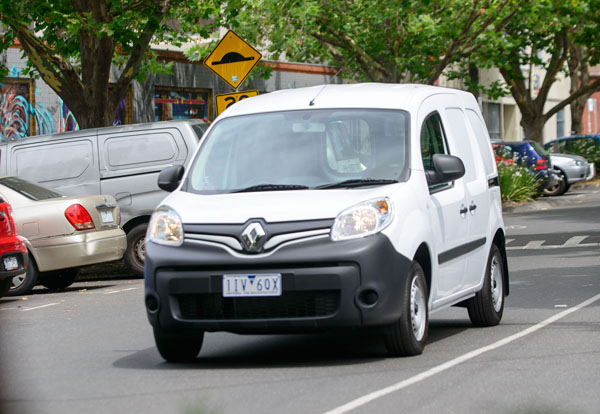When it comes to light commercial vehicles, in this case the Renault Kangoo and Trafic vans, less is more in the new range. Which is no surprise from the company that has been the maker of Europe’s number one van range for the last 18 years in a row.
Thanks to a new 1.2-litre turbocharged petrol engine the Kangoo small family van comes up with better performance and fuel economy than many larger naturally aspirated engine. While to call the new Trafic Crew six-seater a mere van is to sell the vehicle short.
Replacing the previous 1.6-litre four-cylinder petrol, the new Kangoo motor is offered with either a six-speed manual or six-speed Efficient Dual Clutch (EDC) automatic.
The new engine puts out 84 kW at 4500 rpm, more than 1500 revs below the unit it replaces, while direct fuel injection into the combustion chamber, plus turbocharging, has the motor delivering 190 Nm of torque between 2000 and 4000 revs, a 30 per cent increase on the superseded 1.6.
The transmission has been upgraded to match the engine’s advantages, with either a dual clutch six-speed automatic or six-speed manual, both offering better acceleration, carefree cruising and improved fuel economy.
The Kangoo comes in short and long wheelbase, three specification levels – Compact, Maxi or Maxi Crew – with turbocharged petrol or diesel engines, with or without side windows, with or without sliding side doors and asymmetric rear doors or tailgate.
Safety standards have been raised, with the Kangoo Compact 1.2 including driver and passenger airbags, reverse parking sensors, cruise control with speed limiter, plus hill start assist. Active safety continues with ABS anti-skid brakes with emergency brake assist, electronic stability control and traction control.
Accessories ‘du jour’ include AM / FM radio, CD or MP3 audio, controlled through steering-wheel mounted controls, USB input, aux jack, plus hands-free Bluetooth with audio streaming. Optional satellite navigation comes with a 7-inch touch screen, to which can be added a rear-view camera.
The standard tailgate lifts high for full-height rear access. Double barn doors with windows are an option. Oh, and the van gets a cargo area floor covering thrown in.
Space the problem? No worries, Renault offers the Kangoo Maxi, with up to four cubic metres of load area, sliding doors on both flanks and dual rear doors that swing open 180 degrees for ease of working in confined spaces.
At launch, on an extensive drive in city and country conditions both the Kangoo auto and manual delivered up to expectations in the former but fell short on twisting, hilly country roads, tending to wallow and want to wander, especially on fast bends. However, a loaded van may not have been so skittish.
Family requirements have been taken on board by Renault with the introduction of the Kangoo Crew, featuring folding seats, offering spots for up to five people, a versatile cargo area and sliding doors with windows on both sides of the vehicle.
Upgrade to a Lifestyle Pack and the Kangoo Crew adds satellite navigation with touch screen, leather appointed steering wheel, rear air vents, extra tinted windows and the latest fashion in colour-coded bumper.
The long wheelbase twin turbo Trafic Crew people mover-cum-load carrier, with a second row of seats, retains a full four cubic metres of cargo capacity, more than one tonne of payload and the ability to tow up to two tonnes.
Passengers are cut off from cargo, safely ensconced in three individual seats separated by an integrated glazed bulkhead, and have access to storage boxes and pockets under the rear seats and a 12V socket.
Getting in and out is made easy by sliding doors on either side and an anti-slip floor covering. A special order sees the Trafic Crew with two front bucket seats instead of the standard driver and dual front bench set-up. Three-point belts are standard for second-row occupants, along with headrests.
The Crew can be upgraded with an optional Lifestyle Pack which includes MediaNav 7-inch touch screen multimedia and navigation, heated front seat and hands-free key card and engine start.
Powered by an efficient twin-turbo diesel engine, with a claimed combined urban / highway fuel consumption of just 6.2 litres per 100 kilometres, with its 80-litre fuel tank, it is capable of covering more than 1000 km, depending on load and driving conditions.
As was discovered on the launch drive, the bulkhead cuts out excessive cabin noise, vibration and harshness and enables efficient climate control around occupants.
The ride and handling of the Trafic Crew in testing conditions was much more assured than that of its smaller stablemate, the Kangoo, which is only to be expected with a longer wheelbase making for a more stable stance and stiffer and sharper reacting suspension.
Both, however, offer plenty of options for would-be buyers, while both are up against little opposition in the market segment. Prices range from $23,490 for the petrol manual Kangoo to $45,980 for the top Trafic Crew with Lifestyle Package.
Renault does not leave its LCV owners out on a limb, with a three-year / 200,000km warranty, three-year roadside assistance, capped price servicing ($349) for the first three scheduled services and Renault financial services, including insurance.
MODEL RANGE
Renault Kangoo 1.2-litre turbocharged petrol 84kW manual $23,490
Renault Kangoo 1.2-litre turbocharged petrol 84kW EDC $26,490
Renault Kangoo 1.5-litre turbo-diesel Maxi manual $26,990
Renault Kangoo 1.5-litre turbo-diesel Maxi Crew manual $29,490
Renault Trafic Crew $42,990
Renault Trafic Crew with Premium Pack $45,480
Renault Trafic Crew Lifestyle $45,980
Note: These prices do not include government or dealer delivery charges. Contact your local Renault dealer for drive-away prices.
